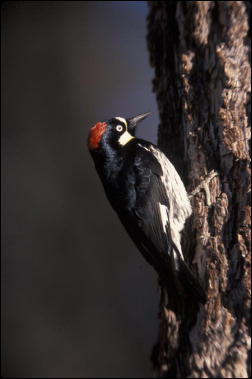
ContextKingdom: AnimaliaPhylum: Chordata Subphylum: Vertebrata Class: Aves Order: Piciformes Family: Picidae |
 |
Photograph by Gary Kramer, courtesy of the U.S. Fish and Wildlife Service. |
The Acorn Woodpecker is a small to medium-sized, black and white "clown-faced" bird. The distinguishing features of this bird is its red-crowned, glossy black and white head, white eyes, and white rump and wing patches. There usually is some yellow and occasionally one or more red-tipped feathers on the throat. The wing length of the woodpecker ranges between 13-15 cm. (Koeing 1995).
"The Acorn Woodpecker prefers pine-oak woodland habitat where oak trees are plentiful. They are also found in riparian corridors and in Douglas fir, redwood, and tropical hardwood forests as long as oaks are available nearby. Urban parks and suburban areas that possess numerous oak trees are often also home to members of the species." (Koeing 1995).
The Acorn Woodpecker can be found from northwestern Oregon, California, the American Southwest, and western Mexico through the Central American highlands and into the northern Andes of Colombia. (Koeing 1995).
"The main diet of the Acorn Woodpecker consists of insects, sap, oak catkins, fruit, and flower nectar. Acorns are critical for winter survival. Occassionally, it eats grass seeds, lizards, and bird eggs. The bird prefers, however, flying ants and other Hymenoptera and Coleoptera. When foraging, the woodpecker often sits at the tops of trees while flycatching. Most foraging, however, is performed in or near the canopy. The woodpecker rarely goes to the ground except to pick up grit and fallen acorns. Usually, acorns are removed singly from trees, but the bird may also break off a twig holding up to three acorns. Sapsucking is a communal affair and group members congregate at a set of holes that are used repeatedly for several years. The Acorn Woodpecker stores insects in cracks or crevices and nuts in indiviually-drilled holes in graneries. A granary tree may hold as many 50,000 holes. Holes are usually drilled in dead limbs and in thick bark during the winter. Any dead or living tree with deep dry bark can used as granary. Studies have shown that these granaries are so important that they are one of the main reasons why acorn woodpeckers live in such large families, at least in California. Only a large group can collect so many acorns and also defend them against other groups." (Koeing 1995).
"Mating systems of Acorn Woodpeckers range from monogamy in some populations to cooperative polygyny. Generally, Acorn Woodpecker groups contain 1-7 male breeders that compete for matings with 1-3 egg-laying females. In groups that contain more than one female breeder, the female cobreeders lay their eggs in the same nest cavity. There is often extreme reproductive competition between joint-nesting females, who regularly destroy eggs laid by their cobreeders. After females have established a normal laying sequence, egg destruction stops. Reproduction competition between males is displayed by attempts by a male to disrupt copulation between another pair. Courtship and pair-bonding displays are absent. Nest cavities are drilled into large dead or living limbs in trees or snags, which may contain granaries. The inside of the nest cavity is lined with fresh wood chips, and nest holes may be used repeatedly for several seasons. Average clutch size for a group with more than one female is five white, elliptical eggs. The average clutch size for a singleton female is four eggs. Eggs are laid at approximately 24-hour intervals. The incubation period is 11 days and both male and female breeders incubate. Once the chicks have hatched, all group members participate in providing food. Nestlings leave the nest after 30-32 days." (Koenig 1995).
The species at the moments has no special threat status; however, there are problems facing the woodpecker. Things like habitat loss and degradation are impending threats; overgrazing, poor regeneration of oaks in California, and destruction of oak and pine forests for firewood or development are among the biggest threats facing the species. (Koeing 1995).
Harris, M. 2002. "Melanerpes formicivorus" (On-line), Animal Diversity Web. Accessed March 13, 2006 at http://animaldiversity.ummz.umich.edu/site/accounts/information/Melanerpes_formicivorus.html
Koenig, W. D., P. B. Stacey, M. T. Stanback, and R. L. Mumme. 1995. Acorn Woodpecker (Melanerpes formicivorus). In The Birds of North America, No. 194 (A. Poole and F. Gill, eds.). The Academy of Natural Sciences, Philadelphia, and The American Ornithologists’ Union, Washington, D.C.
Cristina M. Campbell, March 2006.
